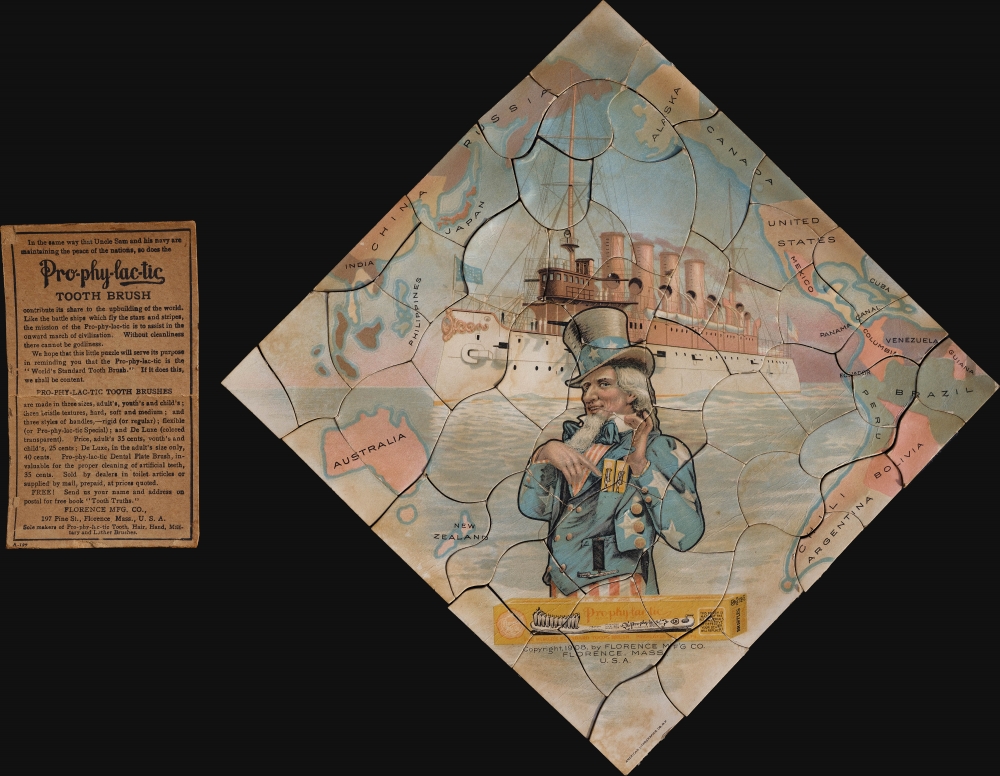1908 American Lithographic Puzzle Map of the World Advertising a Toothbrush
ProPhyLacTic-americanlithographic-1908
Title
1908 (dated) 8.5 x 8.5 in (21.59 x 21.59 cm)
Description
A Closer Look
The image consists of a 54-piece chromolithograph puzzle. It features Uncle Sam with two Pro-phy-lac-tic Tooth Brushes in his breast pocket. In the background is the USS Connecticut (1906 - 1923), a newly made battleship and the flagship of the Great White Fleet. Surrounding the central graphic is a map of the Pacific, including East Asia, the western parts of North America, South America, Australia and New Zealand. It is accompanied by an advertising piece extolling the virtues of the Pro-phy-lac-tic Toothbrush. This was likely a pastedown in the interior of the original box - now unfortunately lost.The Pro-Phy-Lac-Tic Toothbrush
Founded in 1866 in Florence, Massachusetts, by George A. Burr, S.L. Hinckley, D.G. Littlefield, I.S. Parsons, and George A. Scott, the Florence Manufacturing Company originally produced lockets, mirrors, and toilet brushes. By the late 1890s, their production range expanded to toothbrushes, aluminum goods, wooden toilet items, composition brushes, and mirrors. Their best seller was the well-promoted Pro-phy-lac-tic Toothbrush, which so dominated sales by 1924, the company was renamed Pro-Phy-Lac-Tic Brush Company. They were recognized by The Wall Street Journal as the leading toothbrush producer in the U.S. that same year. They also established a factory in Shanghai, China, during the early 20th century, which focused on brush bristle manufacturing. These bristles were then shipped to their Florence location for final toothbrush production. Pro-phy-lac-tic Brush Company and was acquired by the Lambert Pharmaceutical Co. in 1930.The Great White Fleet
Inaugurated under President Theodore Roosevelt, the 'Great White Fleet' was an American naval review in the form of a world cruise lasting from December 16, 1907, to February 22, 1909. It consisted of 16 battleships divided into two squadrons, along with various escorts. The review was intended to demonstrate American naval power and deep-water naval capacity. It is considered a significant episode in the emergence of the United States as a world power. Roosevelt himself considered it one of his greatest accomplishments as president. The term 'White Fleet' refers to the stark white paint on the ship's hulls, leading to a particularly striking appearance. The fleet traveled from Hampton Roads, Virginia, around South America to San Francisco, the west across the pacific to New Zealand, Australia, Japan, the Philippines, Singapore, and India, before rounding the Horn of Africa and passing though the Red Sea, Suez Canal, and Mediterranean, stopping at Gibraltar, before returning across the Atlantic.Chromolithography
Chromolithography, sometimes called oleography, is a color lithographic technique developed in the mid-19th century. The process involved using multiple lithographic stones, one for each color, to yield a rich composite effect. Oftentimes, the process would start with a black basecoat upon which subsequent colors were layered. Some chromolithographs used 30 or more separate lithographic stones to achieve the desired product. Chromolithograph color could also be effectively blended for even more dramatic results. The process became extremely popular in the late 19th and early 20th centuries when it emerged as the dominant method of color printing. The vivid color chromolithography produced made it exceptionally effective for advertising and propaganda imagery.Publication History and Census
This image was prepared in 1907 for by the American Lithographic Company for Florence Manufacturing. We see no other examples either in collections or for sale.Cartographer
The American Lithographic Company (1892 - 1929) was a New York City printing concern active in the late 19th and early 20th centuries. It is considered the first American printing conglomerate. American Lithographic was formed when Joseph Palmer Knapp (1864 - 1951) of the publishing houses Sarony, Major, and Knapp, Major and Knapp, and Knapp and Company, launched a bold plan to consolidate American lithographic printing under one brand. Leveraging his enormous inherited wealth (is father, Joseph Fairchild Knapp (1832 - 1891), was the major shareholder in the Metropolitan Insurance Company), Palmer Knapp consolidated multiple smaller presses, including George S. Harris and Sons, Heppenheimer's and Sons, the Donaldson Brothers Company, the Giles Company, Eddy and Calaus, Witsch and Schmitt, and Schumacher and Ettinger. The consolidation was a hedge to control the lucrative cigar label printing industry. By 1890, prices for color lithography had fallen below sustainable levels due to both the high expense of producing multiple separate stones (one for each color) and favorable manufacturer terms on the purchase of lithographic equipment. This created a highly competitive market, pushing printing prices below cost and driving many smaller companies out of business. By consolidating American lithographic presses under one brand, Knapp hoped to restore industry stability. Initially, the many companies that entered the American Lithographic Company continued to work separately, but by 1900, Knapp centralized production in one large New York City facility. The American Lithographic Company became a major force in American printing, controlling about 75% of the American market for printed graphics. The firm began to decline in the early 20th century when cheaper halftone photographic processes rose to dominate the market. At the same time, demand for fruit and cigar labels, the mainstay of American Lithographic, began to decline. In 1929, the firm was sold to the United States Printing and Lithographic Company, which in 1930 liquidated the cigar label business to Consolidated Lithographing. More by this mapmaker...

